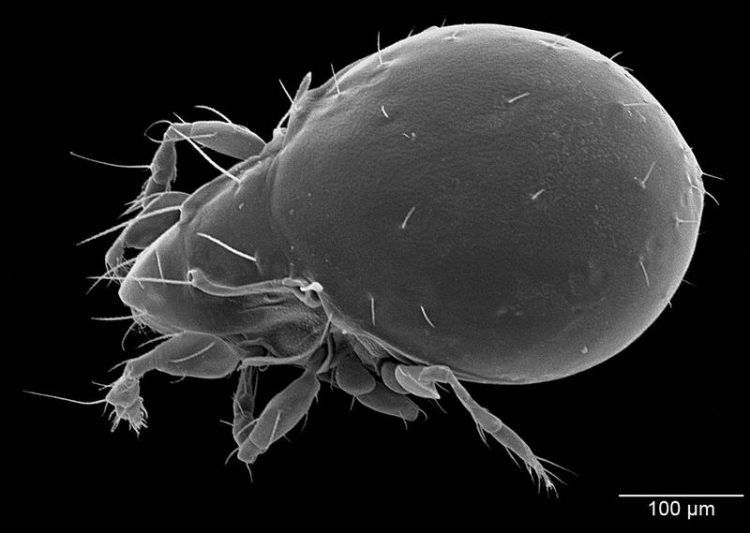Animal poisoners in native forests: Oribatid mite uses hydrogen cyanide for defence

Oribatula tibialis Edith Stabentheiner, Sylvia Schäffer, Günther Raspotnig, Michael Heethoff
Hydrogen cyanide – with the chemical formula HCN – is one of the strongest known toxins. The liquid becomes gaseous at about 25°C and efficiently blocks the respiratory chain, so even tiny quantities will very quickly cause death by suffocation. During the Holocaust, the Nazis used hydrogen cyanide under the name of “Zyklon B” to murder millions of people in the gas chambers of concentration camps such as Auschwitz.
In nature, numerous plants produce the toxin for defence. For instance, the bitter almond: it contains amygdalin, which releases hydrogen cyanide if untreated almonds are consumed. Hydrogen cyanide is extremely rare among animals, since it requires a safe and stable form of storage in order to prevent accidental autointoxication.
It has been thought that this problem had successfully been solved only by some insects and centipedes. Although the more than 80.000 species of arachnids are able to synthesise an impressively broad palette of chemical toxins, none were known that are able to synthesise and store hydrogen cyanide.
Now, though, an international interdisciplinary team of ecologists and chemists from the TU Darmstadt, the University of Graz and the State University of New York (Syracuse) has discovered a new natural product in an oribatid mite that stores and stabilizes hydrogen cyanide in the form of an ester.
Oribatula tibialis measures just half a millimetre, and lives in moss cushions, deadwood and the leaf litter of native forests. When attacked by predators such as predatory mites or centipedes, it releases mandelonitrile hexanoate from its defence glands.
Hydrolysis commences as soon as this ester mixes with the attacker’s saliva and rapidly leads to the release of hydrogen cyanide – thereby instantly putting an end to the tasty meal that had been anticipated. Thus, the tiny mite can defend itself efficiently without taking the risk of autointoxication.
This defence strategy was discovered by the scientists during systematic examinations of the defensive secretions of arachnids. They have now published the results with Dr. Michael Heethoff, Faculty of Biology at the TU Darmstadt as the corresponding author, in the Proceedings of the National Academy of Sciences USA (PNAS).
Publication on the Internet:
Brückner, A., Raspotnig, G., Wehner, K., Meusinger, R., Norton, R.A., Heethoff, M. (2017). Storage and release of hydrogen cyanide in a chelicerate (Oribatula tibialis). Proceedings of the National Academy of Sciences USA, www.pnas.org/cgi/doi/10.1073/pnas.1618327114
Contact:
PD Dr. Michael Heethoff
Tel.: +49 (0) 6151 16-75417
Email: heethoff@bio.tu-darmstadt.de
MI no. 21/2017, Heethoff/sip
Media Contact
More Information:
http://www.tu-darmstadt.de/All latest news from the category: Life Sciences and Chemistry
Articles and reports from the Life Sciences and chemistry area deal with applied and basic research into modern biology, chemistry and human medicine.
Valuable information can be found on a range of life sciences fields including bacteriology, biochemistry, bionics, bioinformatics, biophysics, biotechnology, genetics, geobotany, human biology, marine biology, microbiology, molecular biology, cellular biology, zoology, bioinorganic chemistry, microchemistry and environmental chemistry.
Newest articles

Trotting robots reveal emergence of animal gait transitions
A four-legged robot trained with machine learning by EPFL researchers has learned to avoid falls by spontaneously switching between walking, trotting, and pronking – a milestone for roboticists as well…

Innovation promises to prevent power pole-top fires
Engineers in Australia have found a new way to make power-pole insulators resistant to fire and electrical sparking, promising to prevent dangerous pole-top fires and reduce blackouts. Pole-top fires pose…

Possible alternative to antibiotics produced by bacteria
Antibacterial substance from staphylococci discovered with new mechanism of action against natural competitors. Many bacteria produce substances to gain an advantage over competitors in their highly competitive natural environment. Researchers…





















